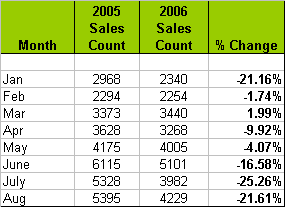
Today the
Federal Reserve Board released its
almost monthly “
Beige Book” report for October, which presents an anecdotal summary of economic conditions in each of the twelve Federal Reserve Bank districts.
Somewhat surprisingly, this edition shows significant slowing, even increasingly slowing conditions for residential real estate and construction activity in
NEARLY EVERY district.
Reading each districts report one after another, its becoming increasingly clear that this housing downturn is truley a "
national" phenomena.
So it seems that Chairman Bernanke’s assessment of “significant” slowing in the housing sector having the effect of trimming 1% off of GDP may be more accurate than the “
Greenspan Bottom” theory.
The following are excerpts from each district report:
BostonAcross New England, the pace of residential sales continues to be slow compared to 2005. In Massachusetts,
the average number of days on the market has increased by a full month since last year, to around 110 days. Contacts attribute slower sales to less urgent buyers focused on getting the highest value for their money. Slow sales combined with increased listings have led to inventory build-up in most New England markets. In Massachusetts, single family inventory has increased 16 percent and condominium inventory has increased 28 percent year-on-year,
leading to around 10 months of supply currently in the market.
Contacts indicate that as sellers have become more attuned to supply conditions in recent months,
they have become more willing to reduce prices.
Correspondingly, many New England markets feature declining prices. The median price of single-family homes sold in Massachusetts in August was about 6 percent below its August 2005 level; the corresponding decline for condominiums was 3 percent.
Contacts
expect that the pace of sales will remain slow in the near term and that markets will continue to show prices below year-earlier levels.
New York
The region's housing market has shown mixed results since the last report, with further weakening noted in northern New Jersey and upstate New York, but signs of underlying strength reported in New York City.
New Jersey homebuilders report that the housing market has continued to slacken since the last report: both buyer traffic and sales activity have declined substantially, the inventory of homes on the market has risen substantially, and prices have continued to slip. One New Jersey contact also notes pronounced weakening in the sub-contracting business, attributing much of the recent weakening in home remodeling to reduced home equity. Similarly, real estate firms in western New York State report that both sales and prices were down moderately in August, compared with a year earlier.
Philadelphia
Bankers in the District expect business and consumer lending to increase in the months ahead, but not strongly. They also expect gains in credit card lending.
However, they anticipate a further decline in the demand for residential mortgages. Some bankers also said they expect an increase in mortgage delinquencies as payments of principal start to become due on non-amortizing mortgages and as rates rise on adjustable-rate mortgages.
Cleveland
Residential contractors reported new home sales are down or flat when compared to earlier this year.
Year-over-year sales declines of 10 percent or more are common with a few contacts saying the market is down by as much as 60 percent. Several contractors reported that they no longer have any backlog. Most home builders expect sales to remain soft for the remainder of the year with 2006 totals to be below those in 2005. Many contacts said that material costs have stabilized over the past couple months with a few noting a drop in the price of lumber.
About half the homebuilders contacted reported reducing their labor force through direct layoffs or by not replacing workers that leave.
Richmond
Residential real estate agents across the District noted generally slower home sales in September.
A Washington, D.C., agent described that area's housing market as "horrible," adding that sales volume was down 25 percent from a year earlier. Additionally, he reported that home inventories had risen sharply and that some sellers were trimming asking prices. In Virginia Beach, Va., an agent also noted weaker home sales, saying that buyers were being more selective. Many District agents told us that inventories in their housing markets continued to rise and that buyer traffic had slowed. Modest decreases in home prices were noted by contacts in many areas, and an agent in Richmond, Va., told us that sellers were offering more incentives to prospective buyers.
Atlanta
Slowing loan demand, aggressive competition for deposits, and strong credit quality, characterized reports from the District's banking sector in September.
Weaker real estate loan demand was noted in most parts of the District, while reports on commercial and industrial lending were softer than in the last report.
Higher foreclosure rates were reported in parts of the region as increased interest rates affected borrowers with adjustable rate mortgages. However, bank credit quality indicators remained strong.
Chicago
Residential construction and
real estate activity declined again in most areas. Homebuilders observed sluggish demand in all market segments, and a Chicago-area builder said high-end properties have been taking noticeably longer to sell.
Builders in southeast Michigan
reported a number of project cancellations. New home prices were steady to down, and
several builders were adding free upgrades to help sell homes. A contact in Michigan noted that list prices of existing homes were being reduced as well.
St. LouisAugust year-to-date home sales declined about 2 percent in both St. Louis and Little Rock. Residential construction remained weak throughout the District. August year-to-date single-family housing permits were down in nearly every metro area. Compared with the same period last year,
permits fell 34 percent in Louisville, 21 percent in greater St. Louis, 11 percent in Memphis, and 8 percent in Little Rock.
Minneapolis
Residential real estate continued to slide. August
home sales in Minneapolis-St. Paul were down 27 percent from 2005, with pending sales down 23 percent. Sales were down 10 percent from last year in the Upper Peninsula of Michigan; the market for recreational land is the only strong segment there.
Kansas City
The residential real estate market continued to soften while commercial real estate activity expanded. Contacts indicated that home starts, traffic of potential buyers, and home prices were down relative to a year ago.
Inventories of existing homes rose and contacts reported that the time-on-market for homes lengthened, despite the increased use of concessions to attract buyers. Home sales were soft in most segments of the housing market, with particular weakness in low to moderately priced housing markets.
Dallas
The housing market continues to soften but remains quite strong. Sales are particularly strong in Houston, Austin and El Paso. Dallas real estate agents say the
"buying fervor" is a little slower, but relocations and healthy job growth are still boosting activity.
New home inventories have inched up, despite strong demand in some markets. Building is
expected to slow from the rapid pace of growth seen earlier this year. While the market remains strong, contacts have become
"more nervous and anxious" in their outlook, especially given recent reports of a decline in housing sales and prices at the national level.
San Francisco
Demand for residential real estate fell further in most areas, while activity in commercial real estate markets continued to expand but at a slower pace than previously in some areas. The pace of home sales, construction, and price appreciation slowed further in most parts of the District, and contacts in some areas noted that
developers have been offering price concessions and other incentives to entice buyers.
 Admit it. You loved the Munster’s mansion.
Admit it. You loved the Munster’s mansion.
























